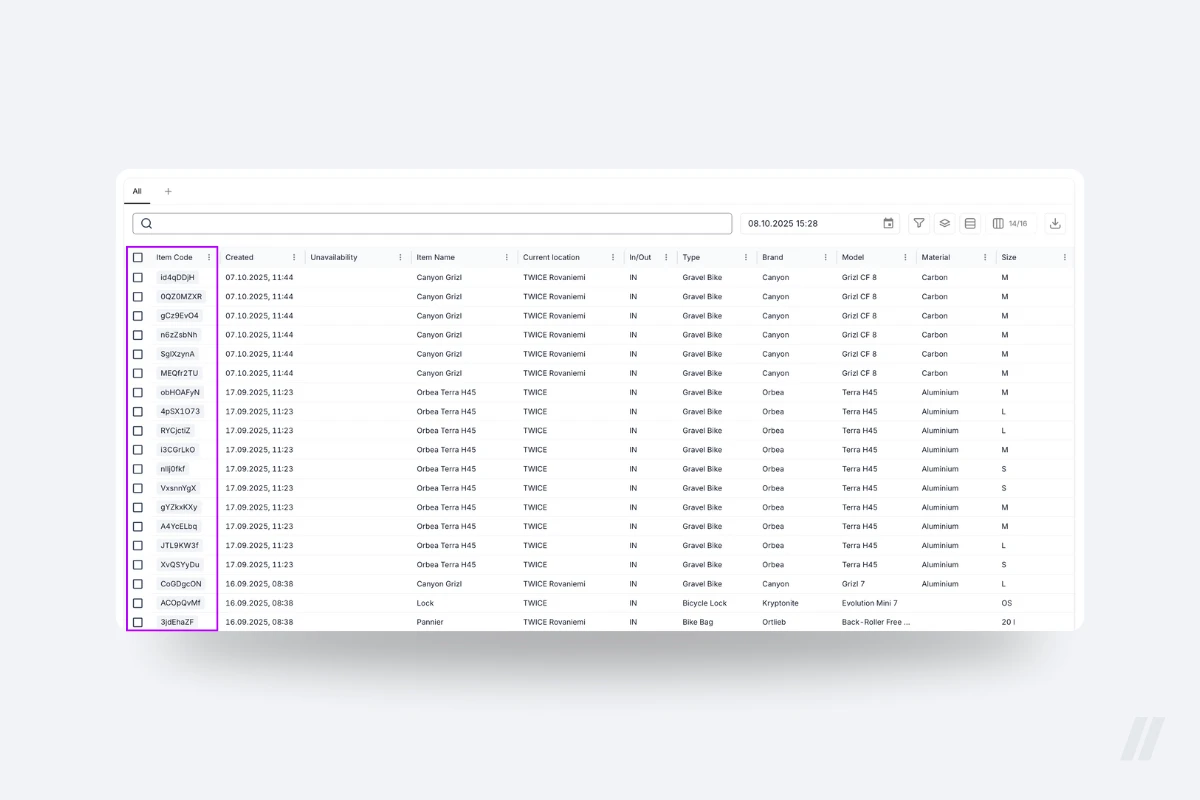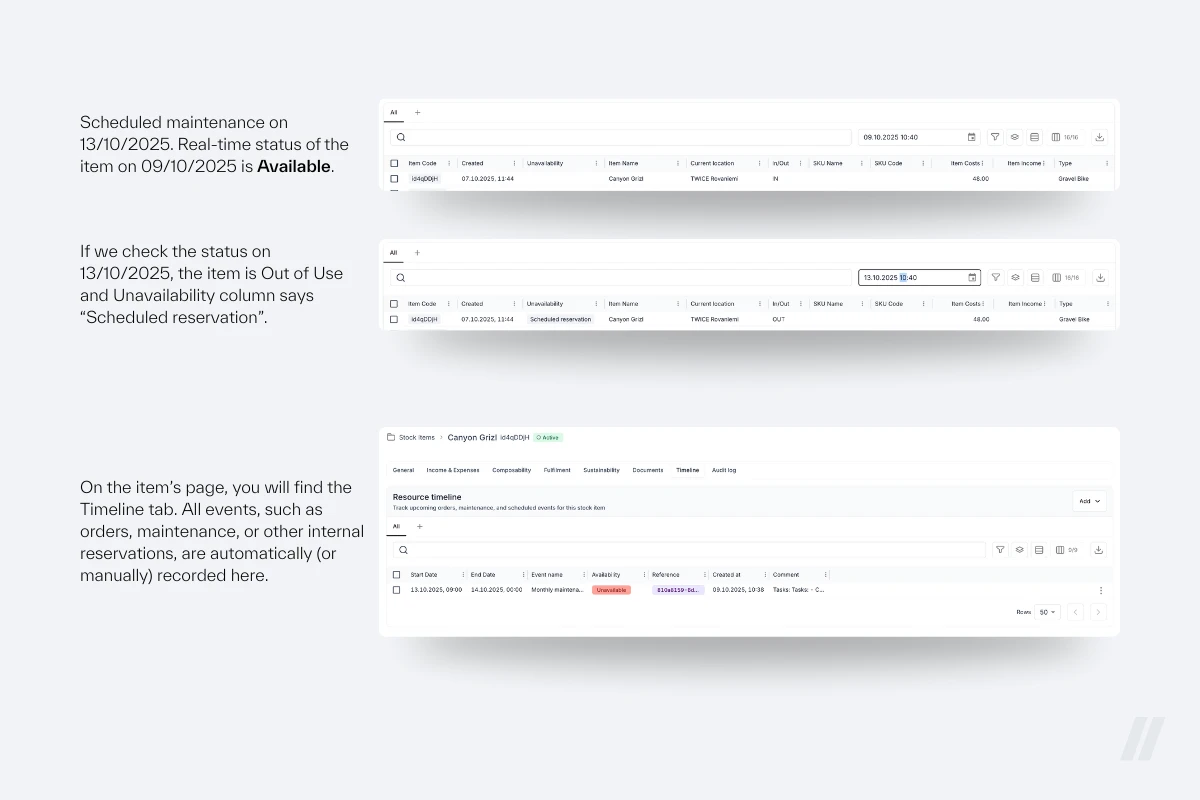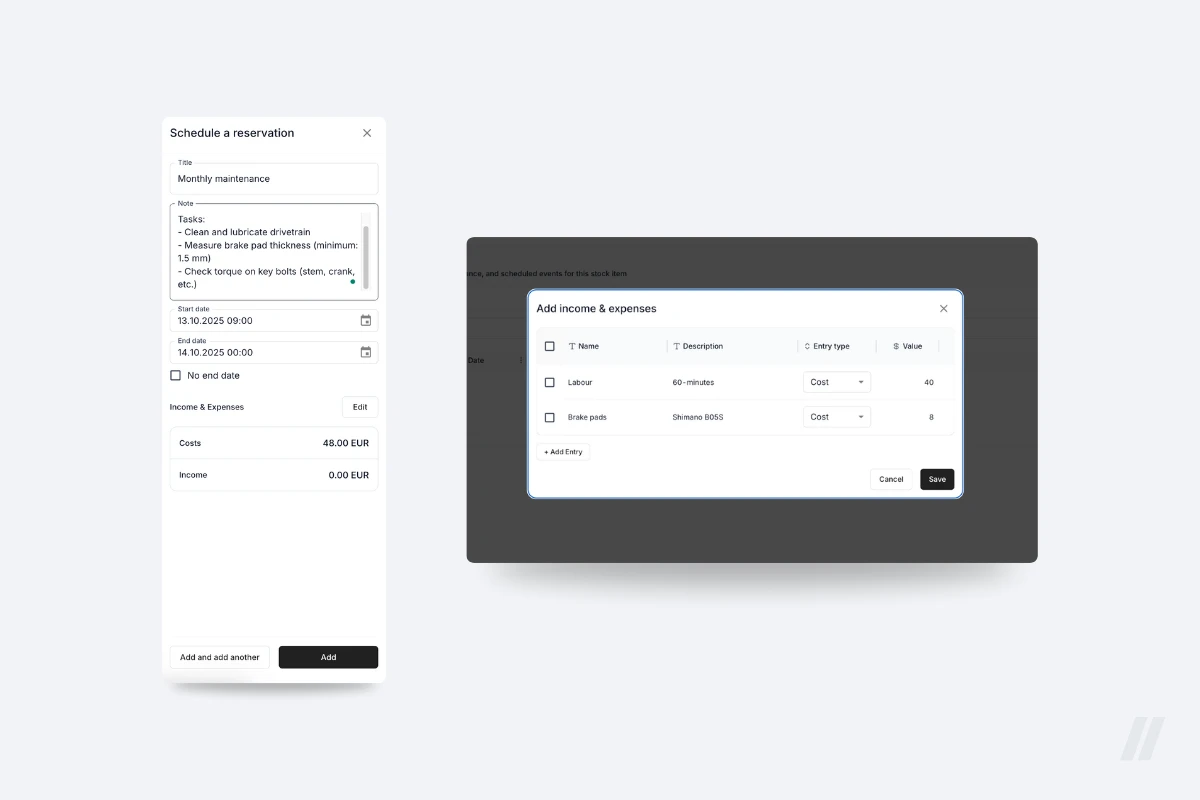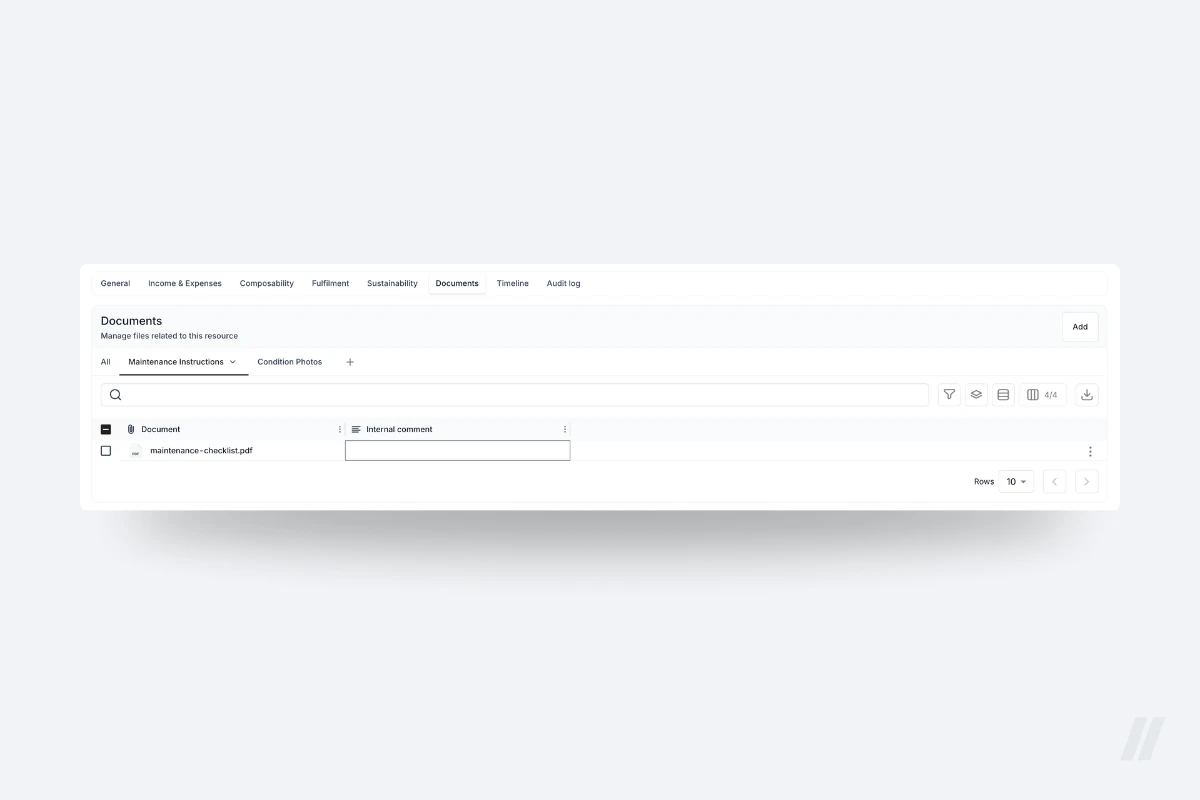
Rental equipment maintenance scheduling is what separates smooth, predictable operations from constant firefighting. If you’re running bikes, AV kits, tools, or outdoor gear across multiple locations, ad-hoc fixes and scattered spreadsheets won’t cut it. You need a framework that repeats itself — one that defines clear frequencies, standardizes inspections, automates reminders, and blocks items for service before they break. At the same time, it must keep utilization high and provide an audit-ready record of every maintenance action.
This guide lays out a practical system for scheduling and tracking maintenance, complete with ready-to-use templates, SOPs, and KPI benchmarks. Use it to reduce breakdowns, increase asset longevity, and prove compliance whenever regulators or partners ask for it.
Maintenance scheduling is your playbook for keeping assets in working order. It defines when each item is inspected or serviced, what gets done, who signs off, and how the work is documented. When done right, it becomes a proactive loop — catching issues before they escalate, keeping safety standards consistent, and making sure every maintenance action is recorded for accountability.
A solid maintenance schedule:
If you’re transitioning away from spreadsheets or manual reminders, this article gives you the high-level structure to streamlining rental equipment maintenance.
The first step in building a reliable maintenance schedule is deciding how often each item should be serviced — and that depends on both time and usage. Time-based intervals ensure nothing gets overlooked, while usage-based rules make sure heavily used gear receives attention before it wears out. The right balance between these two keeps your maintenance program realistic and effective.
Time-based schedules follow a predictable rhythm — weekly, monthly, or seasonal checks. They’re ideal for ensuring consistency, especially for items where wear isn’t directly tied to use, like power tools that need safety inspections or cameras that require regular firmware updates.
Usage-based maintenance, on the other hand, is triggered by activity: the number of rental days, hours in operation, miles ridden, or the total cycles completed. For example, you might tune a bike every 200–300 kilometers or every ten rental days, whichever comes first. These rules adapt to the pace of your business and make sure high-demand items never skip a beat.
A good rule of thumb: start with the manufacturer’s OEM recommendations, then fine-tune based on your own failure and service data. As your records grow, you’ll spot patterns that help optimize both timing and workload.
If you’re just getting started with usage counters, keep it simple. Start with a hybrid rule such as: “every 10 rentals or monthly, whichever comes first.” Over time, your data will tell you which items need closer attention and which can safely stretch their intervals.
For a broader foundation on keeping track of rental assets and their lifecycle, you can pair this with your existing inventory tracking framework in TWICE Commerce — where every asset’s usage data and service triggers live in one place.
A maintenance program only works if it’s consistent — and consistency comes from clear, repeatable Standard Operating Procedures (SOPs). SOPs remove guesswork and help every technician or store location follow the same standards, whether they’re inspecting a bike, testing a camera kit, or servicing a generator.
Think of each SOP as the “recipe” for maintenance: what triggers it, what steps to take, what to record, and when to take an asset out of circulation. When you document these elements properly, you not only prevent skipped checks but also create the audit trail that insurance providers, regulators, and resale buyers love to see.
Each asset type should have its own SOP, structured like this:
Once this pattern is in place, apply it consistently across pre-rental, post-rental, and seasonal inspection routines. This keeps your maintenance language uniform, regardless of who’s performing the work.
At scale, these SOPs also double as training tools. When a new technician joins the team, they learn the expected process immediately instead of picking up habits piecemeal. Over time, you’ll build a library of standardized procedures that preserve quality across every location and every asset.
Even the best maintenance plan falls apart if reminders go unnoticed or if serviced equipment accidentally slips back into circulation. Automation solves this. A well-designed system should handle three core responsibilities reliably: reminding the right person at the right time, preventing bookings during service, and capturing a clean, auditable maintenance history.
Start with reminders. Use system triggers for both time-based and usage-based events — for example, a monthly alert for scheduled safety checks and a “10 rentals completed” trigger for usage-based maintenance. Assign these tasks to roles rather than individuals. That way, if someone is on leave or a team changes, the workflow continues uninterrupted. The system ensures accountability without needing manual supervision.
Next, manage service holds. When an asset hits a maintenance trigger or fails inspection, its status should automatically shift to “Unavailable – Service.” This block should be absolute: the item can’t be booked until it’s cleared by someone authorized to verify the work. Having this rule in place not only prevents operational mistakes but also gives your team a clear line between “safe to rent” and “not yet ready.”
Finally, maintain detailed logs. Every action — from tightening a bolt to replacing a part — should be recorded against the serialized item. Each log entry should include what was done, which parts were used, readings or measurements taken, supporting photos, notes, and the technician’s signature. When issues arise later, these records become your proof of due diligence.
Centralized, serialized inventory systems make all of this seamless. In a platform like TWICE Commerce, each item’s service triggers, history, and availability status are connected in real-time. Once an inspection is marked complete, the system updates the log, clears the hold, and makes the asset rentable again — all without spreadsheets or manual back-and-forth.
Inspections are the frontline of any maintenance program. They catch problems before they affect customers and stop minor issues from becoming expensive downtime later. Every rental transaction — whether it’s a bike going out for the day or a generator hired for a construction project — should begin and end with a clear, repeatable inspection process.
Pre-rental inspections verify that the equipment is safe, functional, and presentable before it leaves your premises. Check that all core functions work, safety equipment is included, and consumables like oil, fluids, or batteries are topped up. Note any cosmetic imperfections so customers understand the condition of the gear before they take it. If an item fails any of these checks, it shouldn’t be released — block it for service immediately and escalate it through your maintenance workflow. A missed inspection here risks customer safety and brand reputation.
Post-rental inspections close the loop. When the item comes back, inspect it again for function, damage, and wear. Clean, disinfect, and document any missing parts or components that need replacement. This is also the moment to update usage counters — hours, kilometers, or cycles — so your system can trigger upcoming service intervals automatically. Even small fixes completed right after return can prevent costlier repairs later.
By making pre- and post-rental inspections non-negotiable, you turn maintenance into an integrated part of your rental workflow, not an afterthought. Over time, these consistent checks create the foundation for reliable uptime, fewer disputes, and longer-lasting assets — all measurable gains in utilization and customer trust.
For certain types of equipment—especially anything electrical, motorized, or high-risk—maintenance isn’t just good practice; it’s a legal requirement. Regulated equipment such as power tools, lifts, or generators must be inspected and documented according to strict safety standards. Failing to keep proper records can jeopardize insurance coverage, violate compliance rules, and expose your business to liability if something goes wrong.
A compliant inspection process is built on traceability. Every check should be tied to the exact serialized item, with a clear record of when it was performed, by whom, and what was found. Each entry becomes part of a continuous audit trail that proves diligence and protects your operation if an incident or claim occurs.
To maintain this level of documentation, keep detailed logs that include:
All of this should live in a centralized system that allows you to export reports as signed PDFs or CSVs. Ideally, these exports are generated quarterly for auditors, insurers, or internal reviews. In TWICE Commerce, for instance, every maintenance log and inspection checklist is tied to a specific serialized asset, making it easy to pull complete, verifiable records without chasing down paperwork.
Building and maintaining this level of compliance discipline doesn’t just satisfy regulators—it strengthens your brand. Customers and partners recognize that safety and accountability aren’t optional extras; they’re part of how you operate.
Once your maintenance program is up and running, measurement becomes the key to improving it. The goal isn’t just to collect data but to understand whether your efforts are making equipment more reliable, efficient, and profitable. Start by tracking a handful of core metrics consistently; expand only when those are well established.
Downtime Rate shows how much of your fleet is unavailable due to maintenance or repair. It’s calculated by dividing total service days by the total number of days in a given period. Over time, you want this percentage to trend downward, reflecting fewer breakdowns and faster turnaround times.
Utilization Rate measures how much each asset is actually earning. It’s the ratio of rented days to total rentable days. Protecting utilization means scheduling maintenance during off-peak periods and avoiding unnecessary idle time. Even small improvements here can have a major impact on revenue.
Maintenance Cost per Rental Day tells you how much upkeep is costing relative to asset activity. Divide total maintenance spend by total rented days. When tracked regularly, this KPI helps you identify cost-intensive items, optimize pricing, and decide when it’s more economical to retire or resell an asset.
Mean Time Between Failures (MTBF) captures how long an item typically operates between incidents. If MTBF rises, it’s a clear sign that preventive maintenance is working.
Mean Time to Repair (MTTR) measures how quickly assets move from “out of service” back to “available.” A shorter MTTR boosts utilization and signals that your maintenance process is running smoothly.
Even a few months of consistent tracking can reveal valuable trends, such as which assets drain resources, which categories perform best, or when seasonal pressure starts to affect uptime. For a broader view of overall operational health, you can connect these indicators with inventory performance metrics in your rental management system. When your KPIs align across maintenance and utilization, you’ll know your process isn’t just organized—it’s profitable.
Transitioning from ad-hoc maintenance tracking to a structured, scalable system doesn’t have to be overwhelming. The key is to start small, establish discipline, and expand once the process feels second nature. Treat your first month as a pilot—long enough to surface real issues, but short enough to adjust quickly.
Run your process as a 30-day pilot on one or two equipment categories. Gather feedback, fine-tune your checklists, and measure compliance. Once you’re confident, roll out the same framework across all categories and locations, tracking KPIs like downtime and MTTR to verify improvement month by month.
If you’re scaling operations across multiple sites or teams, consider integrating maintenance tracking directly into your rental inventory software. In TWICE Commerce, for example, service triggers, holds, and history live inside the same system as bookings and availability—keeping maintenance aligned with fulfillment, not separate from it.
The right maintenance tracker does more than log repairs — it keeps your entire operation predictable and accountable. When evaluating tools, focus on how well they connect inventory, maintenance, and availability rather than chasing features you’ll rarely use. A good system makes it easy for staff to follow procedures, for managers to see what’s next, and for auditors to trust your records.
Start with serialized item tracking. Every asset should have a unique identifier or serial number that ties its full history together — who rented it, when it was serviced, and what parts were replaced. Without serialization, you lose visibility into wear patterns and can’t make confident decisions about resale or retirement.

Next, look for availability controls. The software should let you block or hold assets automatically when they’re due for service or fail an inspection, then release them only after they pass review. This single feature can eliminate most booking mistakes and protect customers from unsafe gear.


Both time- and usage-based triggers are essential. You should be able to set reminders by date (like monthly inspections) and by usage metrics such as hours, cycles, or rental count. Bonus points if the tool tracks these metrics automatically based on order data.
An effective tracker also includes inspection checklists with pass/fail fields, notes, and photos. Having these built into the system instead of being stored in separate PDFs gives you real-time visibility into equipment condition and technician performance.

If your business spans multiple locations, multi-site support is non-negotiable. You’ll want separate service queues and permissions for each branch, with centralized oversight so nothing slips through the cracks.
Barcode or QR code scanning speeds up check-ins, inspections, and logging. It minimizes manual data entry and ensures accuracy during busy turnover days.
When it comes to accountability, audit-ready exports are crucial. Look for the ability to generate time-stamped reports in PDF or CSV formats, complete with technician signatures and photo attachments. This saves hours during audits or insurance claims.
Finally, API access and integrations make a big difference if you already use specialized systems for rentals or repairs. Syncing data automatically between your booking platform and maintenance tracker ensures consistency — no double entry, no missing records.
If you’re choosing between general-purpose maintenance tools and rental-specific software, prioritize systems built for serialized inventory and circular operations. In platforms like TWICE Commerce, service holds, reminders, and maintenance logs are integrated directly with availability and order data. That means less manual work, fewer errors, and complete visibility from rental to repair to resale.
Even the best maintenance strategy falls apart without practical tools for execution. The following templates are designed to help you turn principles into daily routines — structured, repeatable, and easy to adapt across asset categories. Copy, paste, and adjust them to fit your specific gear, usage levels, and team workflow.
Each template focuses on clarity and accountability: what to do, when to do it, how to record it, and who signs off. Whether you manage ten items or ten thousand, these documents make it easy to keep records consistent and inspection-ready.
Asset Type: [e.g., E-bike — Model X]
Trigger(s): Every 10 rentals or 200 km or monthly, whichever comes first
Tasks:
Pass/Fail Criteria: [Define measurable standards]
Parts/Consumables: [List SKUs, quantities, and materials]
Block Rule: Block on fail; lead technician clearance required
Documentation: Photos (before/after), readings, technician signature
Item ID/Serial: ________ Location: ________ Date: ________
Pre-rental (Pass/Fail):
Post-rental (Pass/Fail):
Notes/Photos:
Technician Name & Signature: _______________________
Date/Time: ________ Item ID/Serial: ________ Technician: ________
Trigger: [Time / Usage / Fail]
Work Performed: [Tasks completed according to checklist]
Parts Used: [SKU, quantity]
Measurements/Readings: [Values recorded]
Result: [Pass/Fail]
Next Trigger Due: [Date or usage threshold]
Attachments: [Photo references]
Signature: _______________________
Maintenance scheduling isn’t just about keeping gear in good shape. It’s about protecting revenue, reliability, and reputation. When inspections, logs, and reminders become part of your daily rhythm, you move from reacting to breakdowns to running a truly controlled operation. The result is smoother workflows, higher utilization, and assets that retain value longer, both in use and at resale.
As your business scales, manual systems and spreadsheets inevitably hit their limits. That’s when it pays to have an integrated platform that connects maintenance, inventory, and availability in one place. TWICE Commerce is designed for exactly this kind of operation — giving rental businesses a single system to manage bookings, service triggers, and asset history from start to resale.
By turning maintenance into a measurable process instead of treating it as side task, you set the foundation for long-term profitability and trust. The tools, templates, and KPIs in this guide help you do exactly that: run a fleet that stays ready, safe, and earning, no matter how fast your business grows.
Start with OEM (the manufacturer) guidance. Layer a simple rule: every 10 rentals or monthly. Tighten or loosen based on the Mean Time Between Failures (MTBF) and inspection fail rates.
Use serialized inventory and standardized checklists tied to each item. Log every inspection, service, photo, and sign‑off in one system to keep an audit trail.
Set time‑based calendar reminders and usage‑based triggers (rental count/hours). When a trigger hits or an item fails inspection, mark it unavailable until it passes checks.
Schedule maintenance in low‑demand windows, batch similar services, and shorten Mean Time to Repair (MTTR) with clear escalation steps and pre‑stocked parts.
Downtime rate, utilization, maintenance cost per rental day, MTBF, and MTTR. Review monthly and adjust frequencies accordingly.
Turn every item into lasting revenue. Explore TWICE with a free trial.